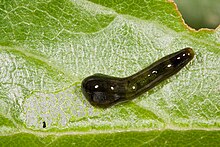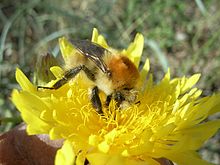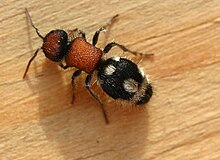Hymenoptera in the 10th edition of Systema Naturae
In the 10th edition of Systema Naturae, Carl Linnaeus classified the arthropods, including insects, arachnids and crustaceans, among his class "Insecta". Insects with membranous wings, including bees, wasps and ants were brought together under the name Hymenoptera.
Cynips (gall wasps)[edit]

- Cynips rosae – Diplolepis rosae
- Cynips hieracii – Aulacidea hieracii[1]
- Cynips glechomae – Liposthenes glechomae[1]
- Cynips quercus baccarum – Neuroterus quercusbaccarum
- Cynips quercus folii – Cynips quercusfolii
- Cynips quercus petioli
- Cynips quercus pedunculi
- Cynips quercus gemmae
- Cynips fagi
- Cynips viminalis
- Cynips salicis strobili
- Cynips amerinae – Euura amerinae[2]
- Cynips psenes – Blastophaga psenes[3]
- Cynips sycomori – Sycophaga sycomori[4]
Tenthredo (sawflies)[edit]




- Tenthredo femorata – Cimbex femoratus
- Tenthredo lutea – Cimbex luteus
- Tenthredo amerinae – Pseudoclavellaria amerinae
- Tenthredo lucorum – Trichiosoma lucorum
- Tenthredo fasciata – Abia fasciata
- Tenthredo americana – Incalia americana
- Tenthredo nitens – Abia nitens
- Tenthredo pini – Diprion pini
- Tenthredo juniperi – Monoctenus juniperi
- Tenthredo ustulata – Arge ustulata
- Tenthredo rustica – Arge rustica
- Tenthredo scrophulariae
- Tenthredo pratensis – Dolerus pratensis
- Tenthredo cerasi – Caliroa cerasi
- Tenthredo salicis – Nematus salicis
- Tenthredo mesomela
- Tenthredo rufipes – Macrophya rufipes
- Tenthredo campestris
- Tenthredo atra – Tenthredella atra
- Tenthredo viridis – Rhogogaster viridis
- Tenthredo rosae – Athalia rosae
- Tenthredo cincta – Allantus cinctus
- Tenthredo livida
- Tenthredo septentrionalis – Craesus septentrionalis
- Tenthredo 12-punctata – Macrophya duodecimpunctata
- Tenthredo erythrocephala – Acantholyda erythrocephala
- Tenthredo abietis – Cephalcia abietis
- Tenthredo sylvatica – Pamphilus sylvaticus
- Tenthredo nemoralis – Neurotoma nemoralis
- Tenthredo cynosbati – ?
- Tenthredo reticulata – Caenolyda reticulata
- Tenthredo betulae – Pamphilus betulae
- Tenthredo saltuum – Neurotoma saltuum
- Tenthredo intercus – ?
- Tenthredo rumicis – Polynematus annulatus[6]
- Tenthredo ulmi – Cladius ulmi
- Tenthredo alni – Craesus septentrionalis
- Tenthredo pruni – Pareophora pruni
- Tenthredo lonicerae – Abia lonicerae
- Tenthredo capreae – Nematus salicis
Ichneumon (ichneumon wasps)[edit]
- Ichneumon gigas
- Ichneumon spectrum – Xeris spectrum
- Ichneumon juvencus – Sirex juvencus
- Ichneumon camelus
- Ichneumon ugillatorius
- Ichneumon raptorius – Diphyus raptorius
- Ichneumon sarcitorius – Ichneumon sarcitorius
- Ichneumon extensorius
- Ichneumon culpatorius – Probolus culpatorius
- Ichneumon constrictorius
- Ichneumon saturatorius – Vulgichneumon saturatorius
- Ichneumon crispatorius – Eutanyacra crispatorius
- Ichneumon pisorius
- Ichneumon luctatorius – Diphyus luctatorius
- Ichneumon volutatorius – Banchus volutatorius
- Ichneumon vaginatorius
- Ichneumon persvasorius – Rhyssa persuasoria
- Ichneumon designatorius
- Ichneumon edictorius – Ctenichneumon edictorius
- Ichneumon deliratorius – Coelichneumon deliratorius
- Ichneumon fossorius
- Ichneumon ariolator
- Ichneumon comitator – Coelichneumon comitator
- Ichneumon peregrinator – Barichneumon peregrinator
- Ichneumon incubitor – Gambrus incubitor
- Ichneumon reluctator – Echthrus reluctator
- Ichneumon denigrator
- Ichneumon desertor
- Ichneumon coruscator – Cratichneumon coruscator
- Ichneumon manifestator – Ephialtes manifestator
- Ichneumon compunctor – Apechthis compunctor
- Ichneumon delusor – Syntactus delusor
- Ichneumon venator
- Ichneumon extensor
- Ichneumon exarator
- Ichneumon turionellae – Pimpla turionellae
- Ichneumon strobilellae
- Ichneumon moderator
- Ichneumon resinellae
- Ichneumon praerogator
- Ichneumon mandator – Agrothereutes mandator
- Ichneumon titillator – Meringopus titillator
- Ichneumon enervator
- Ichneumon gravidator
- Ichneumon inculcator – Itamoplex inculcator
- Ichneumon pugillator – Dusona pugillator
- Ichneumon ruspator
- Ichneumon jaculator
- Ichneumon assectator
- Ichneumon appendigaster
- Ichneumon luteus – Ophion luteus
- Ichneumon ramidulus – Enicospilus ramidulus
- Ichneumon glaucopterus – Opheltes glaucopterus
- Ichneumon circumflexus – Therion circumfiexum
- Ichneumon cinctus – Gelis cinctus
- Ichneumon muscarum
- Ichneumon bedeguaris
- Ichneumon juniperi
- Ichneumon puparum
- Ichneumon larvarum
- Ichneumon cyniphidis
- Ichneumon coccorum
- Ichneumon secalis
- Ichneumon subcutaneus
- Ichneumon aphidum
- Ichneumon ovulorum
- Ichneumon globatus
- Ichneumon glomeratus
- Ichneumon pectinicornis
Sphex (digger wasps)[edit]

- Sphex argillacea – Zeta argillaceum
- Sphex sabulosa – Ammophila sabulosa[7]
- Sphex asiatica – Sceliphron asiaticum
- Sphex fervens
- Sphex inda
- Sphex clavipes
- Sphex spirifex & Sphex aegyptia – Sceliphron spirifex
- Sphex figulus
- Sphex viatica
- Sphex pectinipes
- Sphex variegata
- Sphex indica
- Sphex tropica
- Sphex colon
- Sphex gibba
- Sphex rufipes
- Sphex arenaria
- Sphex fossoria
- Sphex leucostoma
- Sphex vaga
- Sphex caerulea
- Sphex ignita
- Sphex aurata
- Sphex cyanea
Vespa (hornets & wasps)[edit]
- Vespa crabro – European hornet
- Vespa vulgaris – Vespula vulgaris, common wasp
- Vespa rufa – Vespula rufa
- Vespa parietum
- Vespa muraria
- Vespa cribraria
- Vespa spinipes
- Vespa rupestris
- Vespa coarctata
- Vespa arvensis
- Vespa biglumis
- Vespa uniglumis
- Vespa cornuta
- Vespa signata
- Vespa canadensis
- Vespa emarginata
- Vespa calida
Apis (bees)[edit]

- Apis longicornis
- Apis tumulorum
- Apis clavicornis
- Apis centuncularis
- Apis cineraria
- Apis surinamensis – Eufriesea surinamensis
- Apis retusa
- Apis rufa
- Apis bicornis
- Apis truncorum
- Apis dentata – Exaerete dentata
- Apis cordata – Euglossa cordata
- Apis helvola
- Apis succincta
- Apis zonata
- Apis caerulescens
- Apis mellifera – Western honey bee
- Apis subterranea
- Apis variegata
- Apis rostrata
- Apis manicata
- Apis quadridentata
- Apis florisomuis
- Apis conica
- Apis annulata
- Apis ruficornis
- Apis ichneumonea
- Apis cariosa
- Apis violacea – Xylocopa violacea, violet carpenter bee
- Apis terrestris – Bombus terrestris, buff-tailed bumblebee
- Apis lapidaria – Bombus lapidarius, red-tailed bumblebee
- Apis muscorum – Bombus muscorum, moss carder bee
- Apis hypnorum – Bombus hypnorum, new garden bumblebee
- Apis acervorum
- Apis subterranea – Bombus subterraneus, short-haired bumblebee
- Apis surinamensis
- Apis aestuans
- Apis tropica
- Apis alpina – Bombus alpinus
Formica (ants)[edit]

- Formica herculeana – Camponotus herculeana[8]
- Formica rufa[9]
- Formica fusca[8]
- Formica nigra – Lasius nigra[8]
- Formica obsoleta[10]
- Formica rubra – Myrmica rubra[8]
- Formica pharaonis – Monomorium pharaonis[8]
- Formica salomonis – Monomorium salomonis
- Formica saccharivora
- Formica caespitum – Tetramorium caespitum[8]
- Formica omnivora[11]
- Formica bidens – Dolichoderus bidens[12]
- Formica sexdens – Atta sexdens[13]
- Formica cephalotes – Atta cephalotes[14]
- Formica atrata – Cephalotes atratus[15]
- Formica haematoda – Odontomachus haematodus[16]
- Formica foetida – Pachycondyla foetida[17]
Mutilla (velvet ants)[edit]

- Mutilla occidentalis – Dasymutilla occidentalis[18]
- Mutilla americana – Traumatomutilla americana[19]
- Mutilla indica
- Mutilla europaea[20]
- Mutilla barbara – Ronisia barbara
- Mutilla maura – Dasylabris maura[21]
- Mutilla acarorum – Gelis acarorum[22]
- Mutilla formicaria – Gelis formicarius[22]
Notes[edit]
References[edit]
- ^ a b "Nomina – Hymenoptera C". Archived from the original on June 8, 2011. Retrieved September 6, 2010.
- ^ "Euura amerinae (Linnaeus)". Hymenoptera Name Server. Ohio State University. Archived from the original on February 29, 2012. Retrieved September 8, 2010.
- ^ "Nomina – Hymenoptera A–B". Archived from the original on June 8, 2011. Retrieved September 6, 2010.
- ^ J. T. Wiebes (1968). "Fig wasps from Israeli Ficus sycomorus and related East African species (Hymenoptera, Chalcidoidea). 2. Agaonidae (concluded) and Sycophagini" (PDF). Zoologische Mededelingen. 42 (28): 307–321.
- ^ "Hymenoptera Name Server. Version 1.5". Ohio State University. December 19, 2007. Archived from the original on July 23, 2012. Retrieved October 9, 2010.
- ^ Thierry Noblecourt (April 18, 2007). "Liste Systématique des Hyménoptères Symphytes de France" (PDF) (in French).
- ^ Toshko Ljubomirov & Erol Yildirim (2008). Annotated Catalogue of the Ampulicidae, Sphecidae, and Crabronidae (Insecta: Hymenoptera) of Turkey. Pensoft Series Faunistica. Vol. 71. Pensoft Publishers. p. 37. ISBN 978-954-642-312-2.
- ^ a b c d e f "Nomina – Hymenoptera: F-I". Archived from the original on June 22, 2010. Retrieved September 8, 2010.
- ^ Social Insects Specialist Group (1996). "Formica rufa". IUCN Red List of Threatened Species. 1996: e.T8645A12924924. doi:10.2305/IUCN.UK.1996.RLTS.T8645A12924924.en.
- ^ "Formica obsoleta" at the Encyclopedia of Life
- ^ "Formica omnivora" at the Encyclopedia of Life
- ^ "Species: Dolichoderus bidens". AntWeb. Retrieved September 8, 2010.
- ^ "Species: Atta sexdens". AntWeb. Retrieved September 8, 2010.
- ^ "Species: Atta cephalotes". AntWeb. Retrieved September 8, 2010.
- ^ "Species: Cephalotes atratus". AntWeb. Retrieved September 8, 2010.
- ^ "Species: Odontomachus haematodus". AntWeb. Retrieved September 8, 2010.
- ^ "Species: Pachycondyla foetida". AntWeb. Retrieved September 8, 2010.
- ^ James L. Reveal (2009). "Identification of the plant and associated animal images in Catesby's Natural History, with nomenclatural notes and comments". Rhodora. 111 (947): 273–388. doi:10.3119/08-4.1. S2CID 85793102.
- ^ Clarence E. Mickel (1964). "Synonymical notes on Neotropical Mutillidae (Hymenoptera)". Proceedings of the Royal Entomological Society of London B. 33 (9–10): 163–171. doi:10.1111/j.1365-3113.1964.tb01635.x.
- ^ Petr Bogusch (2007). "Vespoidea: Mutillidae (kodulkovití)" (PDF). Acta Entomologica Musei Nationalis Pragae. Supplementum 11: 93–104. Archived from the original (PDF) on 2011-07-20.
- ^ "LINN 2904 Mutilla maura (Ins Linn)". The Linnean Collections. Retrieved September 8, 2010.
- ^ a b M. Schwarz (1995). "Revision der westpaläarktischen Arten der Gattungen Gelis Thunberg mit apteren Weibchen und Thaumatogelis Schmiedeknecht (Hymenoptera, Ichneumonidae). Teil 1" (PDF). Linzer biologische Beiträge. 27 (1): 5–105.


 French
French Deutsch
Deutsch